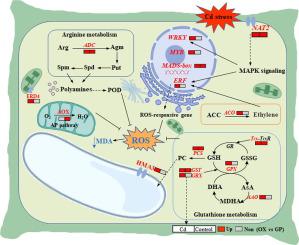Journal of Advanced Research ( IF 11.4 ) Pub Date : 2022-04-09 , DOI: 10.1016/j.jare.2022.04.001 Nian-Hong Wang 1 , Xue-Yi Zhou 1 , Shou-Heng Shi 1 , Shuo Zhang 2 , Zhong-Hua Chen 3 , Mohamed Abdelalim Ali 4 , Imrul Mosaddek Ahmed 5 , Yizhou Wang 1 , Feibo Wu 2

|
Introduction
Cadmium (Cd) is one of the most detrimental heavy metal pollutants, seriously affecting crop production and human health. Nucleobase-ascorbic acid transporters (NAT) are widely present in many living organisms including plants, animals and microbes; however, the role of NAT in plant Cd tolerance remains unknown.
Objectives
To identify Cd-induced miRNAs that target HvNAT2 and to determine the role of this gene and its product in Cd tolerance.
Methods
High-throughput-sequencing was used to identify the miRNA expression profile of barley roots in response to Cd stress. Overexpression (OX) and RNAi lines were then constructed for HvNAT2 and comparative transcriptomic analysis was performed to determine the function of this transporter examining its effects on traits such as Cd uptake/flux and translocation, morphology and antioxidant capacity in relation to Cd tolerance. In addition, phylogenetic analysis was performed to obtain insights into the evolution of HvNAT2.
Results
Cd stress-induced genome-wide expression profiles of miRNAs identified a Cd-induced miRNA, miR156g-3p_3, that had HvNAT2 as its target. HvNAT2 was negatively regulated in the high-Cd-accumulating and Cd-tolerant genotype Zhenong8. Evolutionary analysis indicated that orthologues of the plasma membrane localized, HvNAT2, can be traced back to the sister group of land plants, the streptophyte algae. Overexpression of HvNAT2 increases Cd tolerance with higher tissue Cd accumulation but less oxidative damage in transgenic barley plants. RNAi of HvNAT2 leads to a significant reduction of Cd tolerance. The higher Cd accumulation in roots of the OX3 line was also demonstrated by confocal microscopy and electrophysiology. Transcriptome analysis showed that the enhancement of antioxidant capacity by HvNAT2 was related to stress signaling pathways. Furthermore, oxidative stress tolerance in HvNAT2-OX plants was regulated by the synthesis of phytochelatins and the glutathione metabolism cycle.
Conclusion
Our study reveals a key molecular mechanism of NAT in Cd tolerance in plants that is useful for sustainable agricultural production and management of hazardous this heavy metal for better environment management and ecosystem function.
中文翻译:

miR156 调节的核碱基抗坏血酸转运蛋白 2 通过增强大麦的抗氧化能力赋予镉耐受性
介绍
镉(Cd)是危害最大的重金属污染物之一,严重影响农作物生产和人类健康。核碱基-抗坏血酸转运蛋白(NAT)广泛存在于许多生物体中,包括植物、动物和微生物;然而,NAT 在植物镉耐受性中的作用仍不清楚。
目标
鉴定 Cd 诱导的靶向HvNAT2的 miRNA,并确定该基因及其产物在 Cd 耐受性中的作用。
方法
高通量测序用于鉴定大麦根响应镉胁迫的 miRNA 表达谱。然后构建HvNAT2的过表达 (OX) 和 RNAi 系,并进行比较转录组分析以确定该转运蛋白的功能,检查其对 Cd 吸收/通量和易位、形态和与 Cd 耐受性相关的抗氧化能力等性状的影响。此外,还进行了系统发育分析,以深入了解HvNAT2的进化。
结果
Cd 胁迫诱导的 miRNA 全基因组表达谱鉴定出 Cd 诱导的 miRNA miR156g-3p_3,其以HvNAT2作为其靶标。 HvNAT2在高镉积累和耐镉基因型浙农 8 号中受到负调控。进化分析表明,质膜定位的直系同源物HvNAT2可以追溯到陆地植物的姊妹类群——链藻。在转基因大麦植物中, HvNAT2的过表达可增加镉耐受性,组织中镉积累量较高,但氧化损伤较少。 HvNAT2的 RNAi 导致 Cd 耐受性显着降低。共聚焦显微镜和电生理学也证明了 OX3 系根部 Cd 积累较高。转录组分析表明HvNAT2增强抗氧化能力与应激信号通路有关。此外, HvNAT2 -OX植物的氧化应激耐受性受到植物螯合素的合成和谷胱甘肽代谢循环的调节。
结论
我们的研究揭示了 NAT 在植物耐镉方面的关键分子机制,有助于可持续农业生产和有害重金属的管理,从而实现更好的环境管理和生态系统功能。











































 京公网安备 11010802027423号
京公网安备 11010802027423号